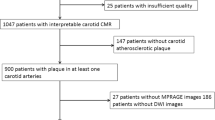Abstract
Introduction
Intracranial internal carotid artery calcifications (ICAC), a frequent finding on imaging studies, are predictive of future stroke risk in population-based studies. The clinical significance of this observation among ischemic stroke patients is however less clear. In this study, we analyzed ICAC burden in relation to vascular risk factor profile, stroke etiology, and extent of craniocervical vascular calcifications in a consecutive series of ischemic stroke patients.
Methods
The burden of ICAC was determined both on non-contrast CT and CT-angiography source images by semiquantitative scoring algorithms. The distribution of vascular risk factors, etiologic stroke subtype, and calcification burden in other craniocervical arteries was assessed among patients with no ICAC, mild–moderate ICAC, and severe ICAC.
Results
Of 319 patients included into the study, 28 % had no ICAC, 35 % had mild–moderate ICAC, and 37 % had severe ICAC on CT angiography. Independent factors associated with ICAC burden in multivariate analysis included age (p < 0.001), diabetes mellitus (p = 0.006), and coronary artery disease (p < 0.001). Furthermore, a stroke etiology of large artery atherosclerosis or cardioaortic embolism was significantly related to higher ICAC burden (p = 0.006). Patients with severe ICAC were more likely to harbor calcifications in other vascular beds (p < 0.001). All of these findings persisted when analyses were repeated with CT-based ICAC burden assessments.
Conclusion
ICAC burden reflects a continuum of atherosclerotic disease involving carotid arteries together with other craniocervical vascular beds. ICAC is significantly associated with stroke of large vessel or cardioembolic origin. This information might help the clinician in prioritizing etiologic work-up in the acute period.

Similar content being viewed by others
References
Bos D, Ikram MA, Elias-Smale SE, Krestin GP, Hofman A, Witteman JC, van der Lugt A, Vernooij MW (2011) Calcification in major vessel beds relates to vascular brain disease. Arterioscler Thromb Vasc Biol 31:2331–2337
Bos D, Portegies ML, van der Lugt A, Bos MJ, Koudstaal PJ, Hofman A, Krestin GP, Franco OH, Vernooij MW, Ikram MA (2014) Intracranial carotid artery atherosclerosis and the risk of stroke in whites: the Rotterdam Study. JAMA Neurol 71:405–411
Bugnicourt JM, Leclercq C, Chillon JM, Diouf M, Deramond H, Canaple S, Lamy C, Massy ZA, Godefroy O (2011) Presence of intracranial artery calcification is associated with mortality and vascular events in patients with ischemic stroke after hospital discharge: a cohort study. Stroke 42:3447–3453
Fisher CM, Gore I, Okabe N, White PD (1965) Calcification of the carotid siphon. Circulation 32:538–548
Woodcock RJ Jr, Goldstein JH, Kallmes DF, Cloft HJ, Phillips CD (1999) Angiographic correlation of CT calcification in the carotid siphon. AJNR Am J Neuroradiol 20:495–499
Hong NR, Seo HS, Lee YH, Kim JH, Seol HY, Lee NJ, Suh S (2011) The correlation between carotid siphon calcification and lacunar infarction. Neuroradiology 53:643–649
Bugnicourt JM, Chillon JM, Tribouilloy C, Canaple S, Lamy C, Massy ZA, Godefroy O (2010) Relation between intracranial artery calcifications and aortic atherosclerosis in ischemic stroke patients. J Neurol 257:1338–1343
Ay H, Benner T, Arsava EM, Furie KL, Singhal AB, Jensen MB, Ayata C, Towfighi A, Smith EE, Chong JY, Koroshetz WJ, Sorensen AG (2007) A computerized algorithm for etiologic classification of ischemic stroke: the Causative Classification of Stroke System. Stroke 38:2979–2984
North American Symptomatic Carotid Endarterectomy Trial (1991) Methods, patient characteristics, and progress. Stroke 22:711–720
Samuels OB, Joseph GJ, Lynn MJ, Smith HA, Chimowitz MI (2000) A standardized method for measuring intracranial arterial stenosis. AJNR Am J Neuroradiol 21:643–646
Babiarz LS, Yousem DM, Bilker W, Wasserman BA (2005) Middle cerebral artery infarction: relationship of cavernous carotid artery calcification. AJNR Am J Neuroradiol 26:1505–1511
Chen XY, Lam WW, Ng HK, Fan YH, Wong KS (2007) Intracranial artery calcification: a newly identified risk factor of ischemic stroke. J Neuroimaging 17:300–303
Marzewski DJ, Furlan AJ, St Louis P, Little JR, Modic MT, Williams G (1982) Intracranial internal carotid artery stenosis: longterm prognosis. Stroke 13:821–824
Chimowitz MI, Caplan LR (2014) Is calcification of intracranial arteries important and how? JAMA Neurol 71:401–402
Weert TT, Cakir H, Rozie S, Cretier S, Meijering E, Dippel DWJ, Lugt A (2009) Intracranial internal carotid artery calcifications: association with vascular risk factors and ischemic cerebrovascular disease. AJNR Am J Neuroradiol 30:177–184
Ptak T, Hunter GH, Avakian R, Novelline RA (2003) Clinical significance of cavernous carotid calcifications encountered on head computed tomography scans performed on patients seen in the emergency department. J Comput Assist Tomogr 27:505–509
Odink AE, van der Lugt A, Hofman A, Hunink MG, Breteler MM, Krestin GP, Witteman JC (2007) Association between calcification in the coronary arteries, aortic arch and carotid arteries: the Rotterdam study. Atherosclerosis 193:408–413
Dijk AC, Fonville S, Zadi T, Hattem AMG, Saiedie G, Koudstaal PJ, Lugt A (2014) Association between arterial calcifications and nonlacunar and lacunar ischemic strokes. Stroke 45:728–733
Ethical standards and patient consent
We declare that all human and animal studies have been approved by the Hacettepe University Institutional Review Board and have therefore been performed in accordance with the ethical standards laid down in the 1964 Declaration of Helsinki and its later amendments. We declare that due to the retrospective design of the study, patient consent was waived.
Conflict of interest
We declare that we have no conflict of interest.
Author information
Authors and Affiliations
Corresponding author
Electronic supplementary material
Below is the link to the electronic supplementary material.
ESM 1
(DOCX 90 kb)
Rights and permissions
About this article
Cite this article
Yilmaz, A., Akpinar, E., Topcuoglu, M.A. et al. Clinical and imaging features associated with intracranial internal carotid artery calcifications in patients with ischemic stroke. Neuroradiology 57, 501–506 (2015). https://doi.org/10.1007/s00234-015-1494-8
Received:
Accepted:
Published:
Issue Date:
DOI: https://doi.org/10.1007/s00234-015-1494-8




